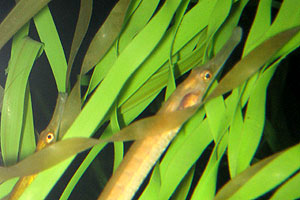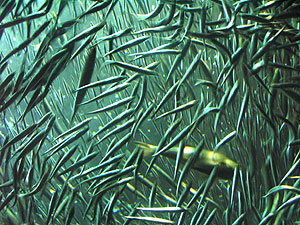 Bay pipefish (Syngnathus leptorhynchus)Our usual view of the Bay doesn't even scratch the surface. Literally. As we admire that beautiful expanse of water, how often do we stop to wonder what’s going on underneath it all?
Bay pipefish (Syngnathus leptorhynchus)Our usual view of the Bay doesn't even scratch the surface. Literally. As we admire that beautiful expanse of water, how often do we stop to wonder what’s going on underneath it all?
The Bay below the surface is a rich ecosystem of worms, snails, anemones, sea stars, clams, shrimp, crabs, and sharks and other fish. The Aquarium of the Bay at PIER 39-- with two underwater tunnels, 700,000 gallons of Bay water, and more than 23,000 animals-- is a great place to get to know some of our neighbors who live in the Bay and in the nearby ocean. Here are just a few of the intriguing creatures we met on a recent tour:
Up first were a bunch of Bay pipefish, who were giving Oscar-worthy performances while pretending to be blades of eelgrass. These long, thin, seahorse relatives are the perfect shape and yellow-green color for camouflage in their favored habitat. The Bay’s shallow-water eelgrass beds are important for other species as well-- providing food and shelter for fish, invertebrates, and waterfowl-- but have been significantly impacted by dredging, development, and pollution.
Downstairs, just inside the first underwater tunnel, we spot one of the Aquarium's newest residents: a giant Pacific octopus "hugging" the top of the tunnel and giving us a great view of its suction cups. One of the largest species of octopus, it lives in the coastal waters of the North Pacific Rim from California through Alaska and Japan. It prefers the intertidal zone down to about 500 feet (like the waters outside the Golden Gate). Octopi, I learn, are the most intelligent invertebrates in the world; in captivity they’ve been taught to solve mazes and unscrew lids from jars to get at seafood snacks.
 School of northern anchovy (Engraulis mordax)Next up is a school of northern anchovy. They are one of the most hypnotic sights in the Aquarium, an ever-shifting whirlpool of silver darts. Facilities Manager Christopher Low tells me they function as both exhibit and lunch, being a good prey food for some of the larger fish in the tank. Though it looks like a lot of fish to me, this school represents just the tip of the iceberg; in the Bay a school of anchovy can reach the size of a football field.
School of northern anchovy (Engraulis mordax)Next up is a school of northern anchovy. They are one of the most hypnotic sights in the Aquarium, an ever-shifting whirlpool of silver darts. Facilities Manager Christopher Low tells me they function as both exhibit and lunch, being a good prey food for some of the larger fish in the tank. Though it looks like a lot of fish to me, this school represents just the tip of the iceberg; in the Bay a school of anchovy can reach the size of a football field.
